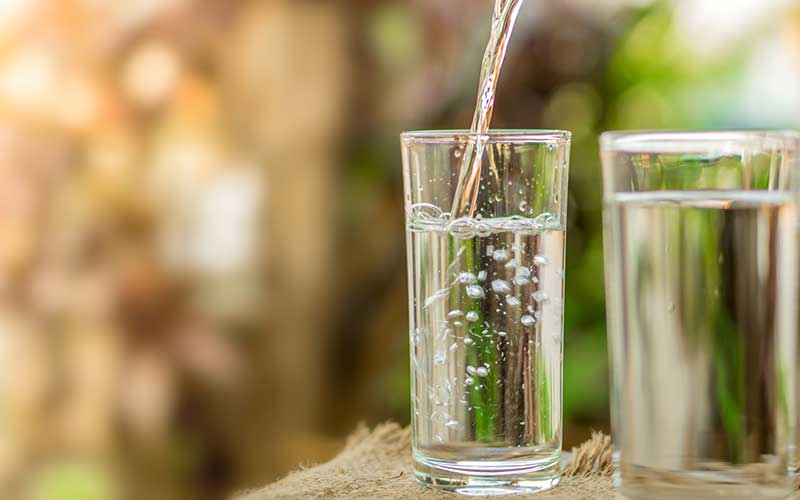
PFAS chemicals are found in drinking water throughout New England. Photo: Doucefleur via Istock
Your clothing, food packaging, nonstick pans, and stain-resistant carpets and furniture likely have one thing in common: They are made with polyfluoroalkyl substances, or PFAS. Known as “forever chemicals,” PFAS are toxic to human health and the environment, but they continue to be used to make many common household items.
And now these dangerous chemicals are being increasingly detected in drinking water sources throughout New England.
“Forever chemicals” is a fitting name. It’s nearly impossible to eliminate PFAS once they have entered the environment. They move through soil and water without degrading. With high heat, the chemicals only become more concentrated and potent. And the only way to ensure they don’t seep into drinking water sources is through filtration – but even then, we cannot get rid of them completely.
PFAS chemicals also remain in the human bloodstream for years, posing significant health risks.
Even though state and federal leaders know about the dangers these chemicals pose, they remain largely unregulated. CLF is working to change that here in New England.
Pervasive and Toxic Chemicals Are Contaminating Our Water
“PFAS” is a general term for thousands of different chemicals used in a variety of products for their unique water-repellent qualities. Most Americans get exposed to PFAS via:
- Food packaging (grease-resistant paper, fast food containers/wrappers, microwave popcorn bags, pizza boxes, and candy wrappers);
- Nonstick cookware;
- Stain- and water-repellent carpets and fabrics;
- Water-resistant clothing;
- Cleaning products;
- Personal care products (shampoo, dental floss) and cosmetics (nail polish, eye makeup); and
- Paints, varnishes, and sealants.
In New England, PFAS contamination has been detected in drinking water sources throughout the region, including at the Pease International Tradeport in New Hampshire; in North Bennington, Vermont; and in Hampden County, Massachusetts.
How Does PFAS Exposure Affect Our Health?
PFAS are toxic to humans in very small amounts, and they stay in our blood for years. No medical interventions will remove them from the body.
While research about the health effects of PFAS exposure is ongoing, scientific studies show that these forever chemicals may:
- Increase the risk of cancer;
- Damage the liver, thyroid, and pancreas;
- Make it harder for a woman to get pregnant;
- Increase the risk of asthma;
- Affect growth, learning, and behavior in infants and children; and
- Interfere with natural human hormones.
Recent studies also show that PFAS can affect the immune system. People who have high PFAS concentration in their blood are more likely to react severely to COVID-19, and their COVID-19 vaccines may even be less effective.
Where Did PFAS Chemicals Come From?
Forever chemicals were first manufactured in the mid-20th century by chemical giants 3M and DuPont. DuPont used one type of PFAS chemical, PFOA, to make Teflon, a material used in non-stick pans. Scientists then altered the original chemical to make waterproof coatings and fire-fighting foam.
DuPont and 3M have long known about the dangers that forever chemicals pose to the environment and public health. But their PFAS-infused products were so profitable that they kept their research a secret. In 1999, the public finally learned the truth about PFAS, when a farmer teamed up with a former chemical industry lawyer to determine why hundreds of his cattle were mysteriously dying.
This famous lawsuit, now immortalized in the movie “Dark Waters,” started a long battle between PFAS manufacturers and advocates for the environment and public health. In 2000, the production of PFOA and another commonly used chemical, PFOS, were phased out voluntarily. However chemical giants then began making new varieties of PFAS. Today, almost 9,000 different kinds of PFAS are in use. And these new forever chemicals may be just as toxic as their predecessors. What’s more, even the phased-out chemicals will remain in drinking water sources for decades to come.
Despite these known dangers, federal regulators have failed to act to protect the public. No federal regulations exist to prevent PFAS contamination. And, while some states have set standards for four or five PFAS chemicals (beyond PFOS and PFOA), the remaining thousands of PFAS chemicals remain unregulated.
Are New England States Regulating PFAS Chemicals?
Here in New England, some states regulate up to five or six PFAS chemicals.
Not only should all New England states have strict PFAS limits, but they should apply to all types of forever chemicals, not just the five or six researched varieties. New Englanders deserve to drink our water with peace of mind, knowing we are protected from these harmful chemicals.
CLF is urging legislators across New England to create strict limits for all types of PFAS. We have made progress in Massachusetts, Vermont, Maine, and New Hampshire, but other states lag behind.
How Can You Protect Yourself?
With so many New Englanders impacted by PFAS contamination, it is important to know how you can protect yourself.
- Filter your water. Drink and cook with water from a certified PFAS filter. Forever chemicals only become more concentrated with heat, so boiling water is not effective in eliminating them. (Check this interactive map to see if your area is affected by PFAS.)
- Replace your cookware. If your pots and pans are “nonstick,” use them only on low heat. Better yet, replace them with cast iron and stainless steel, especially if they have any cracks or deep scratches.
- Be mindful of your takeout. Takeout containers are usually waterproof and stain proof, so are likely to have PFAS. Ask the restaurant what their containers are made of or find out yourself by researching the label and brand on the container.
- Skip water-repellent fabrics. Clothes, carpets, and fabrics marketed as “waterproof” or “stain-resistant” most likely have forever chemicals. While you may think that wearing PFAS is no big deal, as soon as you throw your clothes in the washer, the chemicals are introduced into the water supply.
What Else Can I Do to Stop PFAS contamination?
Join CLF in the fight against PFAS chemicals. Stay up to date on our work by signing up for emails so you’ll know when we need you to speak up and take action.




